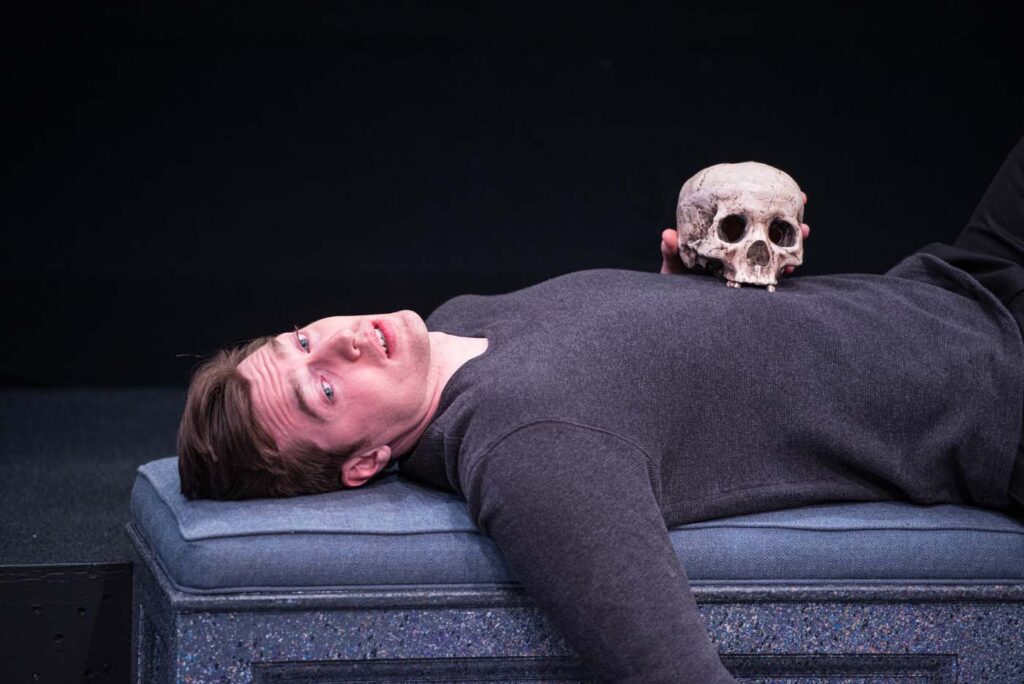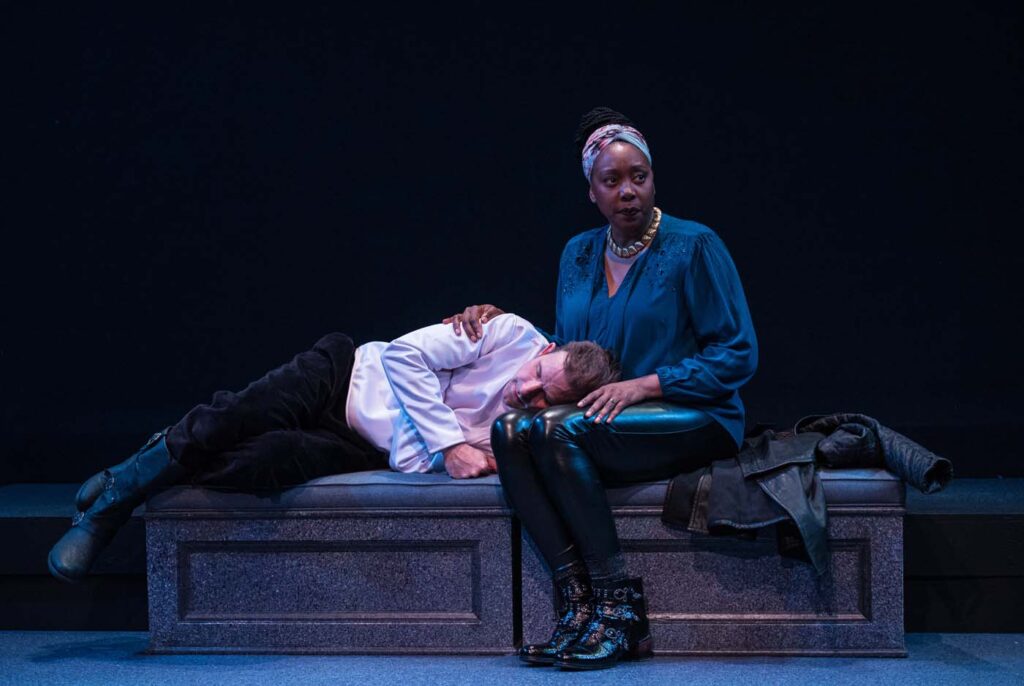
by Jeff Grygny
As the play opens, the lead actor in a prestigious production of Hamlet is throwing a hissy fit. Nothing out of the ordinary there! But in The Last White Man Bill Cain’s provocatively-titled puzzle box of themes and plot twists, which is currently in its world premiere at Next Act Theatre, irony turns on irony like the tormented self-consciousness of the Shakespearean hero. The actor—a Hollywood star with a brand-new Oscar—lays down Yorick’s skull because, just like Hamlet, he is terrified to perform his duty. Thus begins a theater story to top all theater stories, complete with artistic conflicts, backstage intrigue, hot-button politics, psychological suspense—and disco.
It would be totally unfair to reveal any of the details of the Escher-like plot that Cain has constructed, but there’s still a lot to say about this play, which will undoubtedly ruffle a few feathers and start many lively conversations. Cain is a brave man, venturing into one of the culture war’s most radioactive regions: the issues of representation in the arts, and reading the classics through the lens of identity politics. He might incur some folks’ wrath for daring to write the part of Xandri, a Black woman director, though he treats the character respectfully. Then there’s the moment when the understudy, Rafe, asserts that Hamlet should never be played by a Black actor because he’s Danish. When his replacement, the actor named Tigg, protests, he retorts “Can a White actor play Othello?” It turns out (and this isn’t really a spoiler, since it’s in the publicity and program notes that Cain himself believes this) that Xandri’s goal is to direct a production of Hamlet so good that the play will never need to be performed ever again. Acknowledging that the play’s genius contains all of Western civilization, she adds. “And it leads to destruction and death. Always.”
Another risky move on Cain’s part is to require the actors perform at various levels of talent.. As the spoiled, troubled film star, Ken Miller brings the effortless grace that could anchor a blockbuster movie, but his character’s Shakespearean delivery is of the the hit-or-miss “know what you’re saying and talk fast” school that’s murder on the poetry. In the role of Rafe, the understudy who is called in after some unspecified incident takes Charlie out of the picture, Neil Brookshire didn’t have to imagine what the understudy feels like when suddenly thrust onstage: he is himself the understudy for JJ Gatesman, who was recovering from a mild bout with Covid. Brookshire stepped into the role seamlessly, showing both the character’s intense drive to succeed and the actor’s psychological insight—that just might be employed in manipulating the other characters.
As Xandri, Demetria Thomas renders a sympathetic, smart, and grounded persona. And as Tigg, the replacement Hamlet, Brian Gill has the job of playing a consummate artist, spelunking the famous role’s humanity buried in layers of centuries. No pressure! But he acquits himself admirably and honestly. Director David Cecsarini leads his cast of four with economy and a minimum of flash. I rather regretted, though, that the performers, perhaps out of caution to avoid offensive stereotyping, playing a Black woman and two gay men in the 80s, display little of the rich panache of their respective subcultures. The unintended effect of this restraint is to make them all sound more or less like the playwright’s mouthpieces.
So—let’s talk for a minute about Hamlet the play. Is it indeed a theatrical monster, a relic of patriarchal oppression like a Confederate monument, worthy only for the trash heap of history? First off, it’s a very weird play, full of twists and odd angles. Partly this is because Shakespeare adapted it from the Twelfth Century Scandinavian story of Prince Amleth, which is itself full of medieval weirdness, including the prince pretending to be an idiot so that nobody would suspect him of seeking revenge on his uncle. Similar tales appear in Roman literature, also in Finland, Ireland, France, India, and in Arabic sources. This ubiquity has led some scholars to theorize that the story originated in Indo-European culture, which is to say, the people who spread their language from the Early Bronze Age on all across the Western hemisphere. So the story is really really old—and associated with the people formerly known as the “Aryans,” whom we might remember as the Nazis’ so-called “master race.” So that’s a bit of baggage (is this why a cloaked figure in a Bronze Age helmet keeps stalking the stage?).
But there’s more! Hamlet was famously given as a textbook example of Freud’s Oedipus complex, a notorious structure of the masculine subconscious. (If you want to know how deep that rabbit hole goes, google Deleuze and Guattari’s The Anti-Oedipus.) And for a cherry on top, some cognitive scientists have speculated that Hamlet represents an early expression of the emergence of modern consciousness, both as a self-reflective, autonomous self and as a highly conflicted and alienated one. Whew! Maybe the play does contain all of Western civilization. And maybe not in a good way!
One of Shakespeare’s innovations was to disrupt the conventional revenge plot by having the protagonist actually stop and question what he was doing, ultimately coming to the realization that, like Arjuna in the Bhagavad Gita, or a Japanese samurai, he can only do what must be done in the situation he’s in, and be at peace with that. “The readiness is all. Let be.” It’s still the ethos of a warrior culture—but a self-aware one. In a world that’s “out of joint,” sometimes that’s all one can do.

The Last White Man is a brand new play, never before produced. So how does it do? It’s certainly not boring— I can’t speak for people less familiar with Hamlet, but for a Shakespeare nerd like me, it’s compelling from beginning to end. Cain’s back-and-forth chronology keeps the suspense going, but I for one left pretty fuzzy as to what exactly happened with Charlie, either because I was inattentive or because it was left ambiguous. Then there is the slight problem of all the characters sounding somewhat the same. And although the economics of theater today demand small casts, I’d have loved to have seen a full-out theater milieu, with Ophelia, Fortinbras, extras, crew, and all the rest. The play’s climactic scene loses credibility because some of the characters’ actions seem jarringly desperate. It might make more sense if we had more a feel of a grand production: restless audience, nervous patrons, critics waiting to pounce, and all that.
But the questions the play raises are powerful. Are we beholden to the judgements of former generations, like old politicians clinging to power beyond their time? Or can we value the riches of the past while letting new generations see them afresh and make them anew? In the end, even Cain seems to show that new perspectives can bring insights to even this hoary classic. And he’ll start some lively discussions. In that regard, The Last White Man works just fine.
By all means, let’s hear new voices telling new stories. But I’m willing to wager that, somehow, Hamlet will survive.
Next Act Theatre presents
The Last White Man
by Bill Cain
Directed by David Cecsarini
playing through May 8
